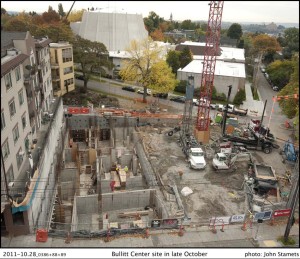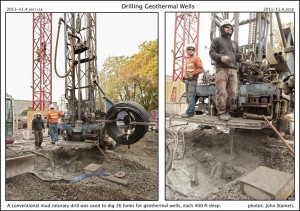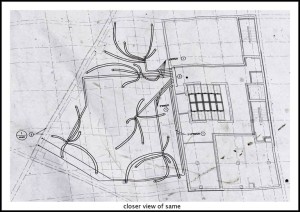Ground Source Heat Pumps at the Bullitt Center
All of the energy used at the Bullitt Center will be generated onsite as required by the Living Building Challenge, which prohibits combustion of fossil fuels to heat, cool or power the building. Solar thermal heating is inadequate during most of our cloudy winter days, and there simply isn’t enough wind available to reliably produce sufficient electricity. This leaves solar electricity produced by photovoltaics as the only viable on-site option. The energy for the Bullitt Center will be generated by photovoltaic panels on the roof of the building. Since this energy will be shared between all building systems, an energy-efficient heating and cooling system is required.
Electric resistance heating is the cheapest and most direct way to heat a building with electricity, but to heat and cool a building with greater efficiency, a water source heat pump is the ticket. A heat pump employs the compression-refrigeration cycle common to both refrigerators and window air conditioning units. The heat pump is a remarkable system, using relatively little electric energy, consumed mostly to run a compressor, to transfer (or exchange) heat from one place to another with amazing efficiency. One side, the evaporator coils, cools the air or water passing by, while the other side, the condenser coils, heats the air or water passing by it. In this case, relatively low temperature energy from the ground is bumped-up in temperature and transferred to water to heat the building through the “magic” of a heat pump.
The heat pump uses a refrigerant in a closed loop that changes state from liquid to gas and back again as it circulates through the pump. In the system at the Bullitt Center, heat from a ground well loop arrives at the evaporator stage of the heat pump and is absorbed by the fluid, which converts the fluid to a gas. This gas is then compressed into a hot and high-pressure vapor by the compressor. The high temperature vapor is circulated through condenser coils in contact with water from a separate loop, heating this water that is circulated through tubing embedded in the concrete floors to heat the building. This causes the gas in the heat pump to condense into warm, pressurized liquid, which is passed through an expansion valve, converting it to a cold, low-pressure liquid. In the evaporator coils, this cold fluid draws heat again from the relatively warm ground water loop where it boils into a gas and the cycle is repeated.
In essence, solar heat stored in the ground is transferred to the building by the heat pump to warm the building in the winter. In hot summer months, heat from the building is “pumped” back into the ground, cooling the building. Since the Earth remains at a constant temperature of 55° a short distance below the surface, its energy can be used as a heat source in the winter and a heat sink in the summer, an abundant and reliable source of thermal mass year-round.
The system at the Bullitt Center consists of three interlocking closed loops. One set of loops circulates a solution of water and (25%) glycol, an anti-freeze, through twenty-six 400’-deep wells drilled under the building, to transfer heat energy to a second closed-loop within the heat pump itself. This loop connects with both the ground-source loop and the third closed-loop which circulates warmed water through the floors in the winter. In the summer, the heat pump’s evaporator and condenser coils can switch roles, allowing the system to draw heat from the building and transfer this energy into the relatively cool earth.
Three ground source heat pumps are used to heat or cool the water circulated through the floor slabs. A fourth heat pump sends its loop of heated or cooled water to condition the outside air passing through the heat recovery ventilator located on the building’s roof. A fifth heat pump is used exclusively to heat water.
The energy used to power the ground source heat pumps is generated on-site, so no fuels have to be purchased, transported and burned at the site; no waste products are created, and nothing requires disposal. This ground source heat pump system is highly energy efficient, helping the Bullitt Center to meet the energy needs of the building using only a small fraction (~5%) of the energy produced on site by the photovoltaic panels on the roof.



